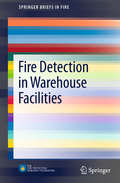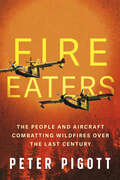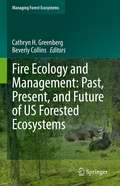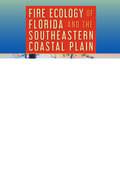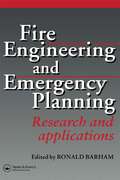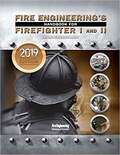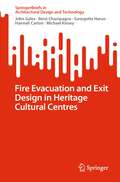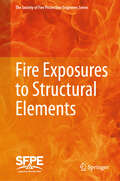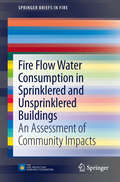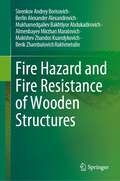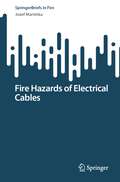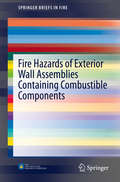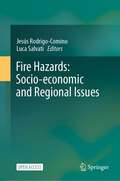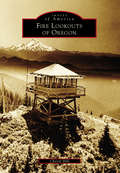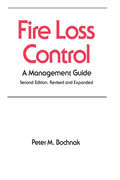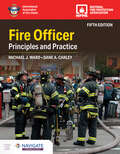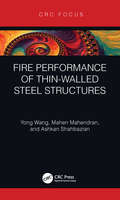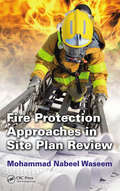- Table View
- List View
Fire Detection in Warehouse Facilities
by Daniel T. Gottuk Joshua DinaburgAutomatic sprinklers systems are the primary fire protection system in warehouse and storage facilities. The effectiveness of this strategy has come into question due to the challenges presented by modern warehouse facilities, including increased storage heights and areas, automated storage retrieval systems (ASRS), limitations on water supplies, and changes in firefighting strategies. The application of fire detection devices used to provide early warning and notification of incipient warehouse fire events is being considered as a component of modern warehouse fire protection. Fire Detection in Warehouse Facilities provides technical information to aid in the development of guidelines and standards for the use of fire detection technologies for modern warehouse fire protection. The authors share their thorough literature review, analyze characteristic fire hazards for modern warehouse facilities, and identify information gaps in the field. The book concludes with recommendations for the development of guidelines and standards for the use of detection technologies in warehouse fire protection design, including a research plan for implementation. This book is intended for practitioners seeking an understanding of the issues surrounding warehouse design and fire protection. The book will also prove valuable for fire hazard researchers and those involved with fire department response, applicable detection systems, and fire growth suppression.
Fire Eaters: The People and Aircraft Combatting Wildfires Over the Last Century
by Peter PigottThe riveting history of how aircraft have transformed the fighting of wildfires. Throughout history, when threatened by wildfires our only defense was to pray for rain and run — until aircraft changed the way we fight fires. Beginning with the Canadian “H-Boats” in 1924, aircraft have become indispensable in detecting and extinguishing wildfires. Fire Eaters tells the incredible stories of the Ontario Provincial Air Service, the first government aerial fire suppression organization in history; one of its pilots, Carl Crossley, who invented the water scoop-up and drop-off system; and the Canadair CL-215, the first purpose-built water bomber. Today, helicopters with “Bambi Buckets” and snorkels can dump water while hovering directly over the flames, and Air Tractors and Dash 8-400AT air tankers not only perform a crucial role in saving communities but also protect our ecosystem. Satellites — unmanned aircraft able to fly for sixteen hours, even overnight when manned aircraft do not — and artificial intelligence already play a decisive role in fire management. But it is the men and women of the aerial fire service who have really changed the way we fight fire around the world. Their bravery and dedication mean that response times are fast, fires can be contained sooner, and people have the chance to save rather than lose everything.
Fire Ecology and Management: Past, Present, and Future of US Forested Ecosystems (Managing Forest Ecosystems #39)
by Beverly Collins Cathryn H. GreenbergThis edited volume presents original scientific research and knowledge synthesis covering the past, present, and potential future fire ecology of major US forest types, with implications for forest management in a changing climate. The editors and authors highlight broad patterns among ecoregions and forest types, as well as detailed information for individual ecoregions, for fire frequencies and severities, fire effects on tree mortality and regeneration, and levels of fire-dependency by plant and animal communities. The foreword addresses emerging ecological and fire management challenges for forests, in relation to sustainable development goals as highlighted in recent government reports. An introductory chapter highlights patterns of variation in frequencies, severities, scales, and spatial patterns of fire across ecoregions and among forested ecosystems across the US in relation to climate, fuels, topography and soils, ignition sources (lightning or anthropogenic), and vegetation. Separate chapters by respected experts delve into the fire ecology of major forest types within US ecoregions, with a focus on the level of plant and animal fire-dependency, and the role of fire in maintaining forest composition and structure. The regional chapters also include discussion of historic natural (lightning-ignited) and anthropogenic (Native American; settlers) fire regimes, current fire regimes as influenced by recent decades of fire suppression and land use history, and fire management in relation to ecosystem integrity and restoration, wildfire threat, and climate change. The summary chapter combines the major points of each chapter, in a synthesis of US-wide fire ecology and forest management into the future.This book provides current, organized, readily accessible information for the conservation community, land managers, scientists, students and educators, and others interested in how fire behavior and effects on structure and composition differ among ecoregions and forest types, and what that means for forest management today and in the future.
Fire Ecology of Florida and the Southeastern Coastal Plain
by Reed F. NossAn overview of the importance of fire to ecosystems in the Southeast, with guidance on how to best conduct controlled burns in the regionA biodiversity hotspot, Florida is home to many ecosystems and species that evolved in the presence of frequent fire. In this book, Reed Noss discusses the essential role of fire in generating biodiversity and offers best practices for using fire to keep the region's ecosystems healthy and resilient. Reviewing several lines of evidence, Noss shows that fire has been important to the southeastern Coastal Plain for tens of millions of years. He explains how the region's natural fire regimes are connected to its climate, high rate of lightning strikes, physical chemistry, and vegetation. But urbanization and active fire suppression have reduced the frequency and extent of fires. Noss suggests the practice of controlled burning can and should be improved to protect fire-dependent species and natural communities from decline and extinction. Noss argues that fire managers should attempt to simulate natural fire regimes when conducting controlled burns. Based on what the species of the Southeast likely experienced during their evolutionary histories, he makes recommendations about pyrodiversity, how often and in what seasons to burn, the optimal heterogeneity of burns, mechanical treatments such as cutting and roller-chopping, and the proper use of fuel breaks. In doing so, Noss is the first to apply the new discipline of evolutionary fire ecology to a specific region. This book is a fascinating history of fire ecology in Florida, an enlightening look at why fire matters to the region, and a necessary resource for conservationists and fire managers in the state and elsewhere.
Fire Ecology of Pacific Northwest Forests
by James K AgeeThe structure of most virgin forests in the western United States reflects a past disturbance history that includes forest fire. James K. Agee, an expert in the emergent field of fire ecology, analyzes the ecological role of fire in the creation and maintenance of natural western forests, focusing primarily on forest stand development patterns. His discussion of the natural fire environment and the environmental effects of fire is applicable to a wide range of temperate forests.
Fire Engineering and Emergency Planning: Research and applications
by R. BarhamProtection against fire and prevention of explosion is vital in a modern industrial economy. This published proceedings of the First European Conference on Fire Engineering and Emergency Planning provides an authoritative base of materials covering the latest research, applications and hypotheses as a cumulative reference work and a platform for exchanges of ideas within the academic fire community.
Fire Engineering of Structures
by M.Y.H. Bangash Y.F. Al-Obaid F. N. BangashThis book provides a general introduction to the three-dimensional analysis and design of buildings for resistance to the effects of fire and is intended for a general readership, especially those with an interest in the design and construction of buildings under severe loads. A major aspect of design for fire resistance involves the building elements or components. The emphasis is placed on structure, which has a primary role in preventing serious damage or structural collapse. Much of the material in this book examines building structures. The designed examples are based on three-dimensional finite elements.
Fire Engineering's Handbook for Firefighter 1 and 2
by Glenn CorbettFire Engineering’s Handbook for Firefighter I & II is written to 2019 NFPA Standards 1001. From fire service history to basic fire attack and building construction to firefighter safety, Fire Engineering’s 2019 update is the standard instruction handbook for firefighters. <p><p>It contains lessons learned from more than 40 experienced subject-matter experts who share their insight and knowledge. Edited by Glenn Corbett, Fire Engineering magazine’s technical editor, this 2019 update gives readers practical, real-world, time-tested knowledge and skills.
Fire Evacuation and Exit Design in Heritage Cultural Centres (SpringerBriefs in Architectural Design and Technology)
by John Gales René Champagne Georgette Harun Hannah Carton Michael KinseyThis book highlights human behaviour and architectural considerations for prescriptive code requirements for emergency exits in heritage cultural centers. Closed circuit television camera (CCTV) footage from a Canadian heritage cultural centre was analyzed from three separate unannounced evacuations, where recommendations based on the first two evacuations were implemented for the third. This study aims to (1) develop a baseline for the behaviour and actions of people during the pre-movement and movement stages of emergency egress and evacuation situations and (2) collect behavioural and movement data to aid the fire safety community with the decision process for egress and evacuation strategies and (3) interrogate and highlight architectural barriers in heritage structures with respect to emergency evacuation. The discussion of findings includes occupant behaviour, architectural implications and evacuation modelling and considers the often-conflicting intersection between architectural conservation and fire safety.
Fire Exposures to Structural Elements (The Society of Fire Protection Engineers Series)
by Society for Fire Protection EngineersThis volume provides the information and methodology needed to predict the thermal boundary condition for a fire over time. The methods contained herein are based on experimental measurements and correlations, and mostly give global rather than local results. Eventually, computational fluid dynamics methods for fire must be subjected to some of the same tests used here and judged accordingly for accuracy and application.
Fire Fighter! (Eyewitness Readers level #2)
by Angela RoystonDescribes a day in the life of a group of fire fighters
Fire Flow Water Consumption in Sprinklered and Unsprinklered Buildings: An Assessment of Community Impacts
by Inc. Code ConsultantsFire Flow Water Consumption in Sprinklered and Unsprinklered Buildings offers a detailed analysis for calculating the fire water demand required in buildings with existing and non-existant sprinkler systems. The installation of automatic sprinkler systems can significantly reduce the amount of water needed during a fire, but it requires water for commissioning, inspection, testing, and maintenance (CITM). This book provides an estimate of fire water used under both fire conditions, including CITM, to allow communities to develop fire water fees for both sprinklered and unsprinklered buildings that are proportional to the anticipated fire water usage. The types of buildings analyzed include residential (family dwellings as well as those up to four stories in height), business, assembly, institutional, mercantile, and storage facilities. Water volume was studied using guidelines from the International Code Council, the National Fire Protection Association, and the Insurance Services Office. Fire Flow Water Consumption in Sprinklered and Unsprinklered Buildings is intended for practitioners as a tool for analyzing water consumption in fire situations and for providing them with key information on the best types of water systems in a variety of buildings. Researchers working in building planning and safety will also find the book valuable.
Fire Hazard and Fire Resistance of Wooden Structures
by Sivenkov Andrey Borisovich Berlin Alexander Alexandrovich Mukhamedgaliev Bakhtiyor Abdukadirovich Almenbayev Mirzhan Maratovich Makishev Zhandos Kuandykovich Berik Zhambulovich RakhmetulinThis monograph discusses fire hazard and fire resistance in wooden structures with a long duration of operation. Aside from its increasing importance for modern architecture, wood has been the most important building material in the past. It has a distinct aesthetic, high mechanical strength, and resistance against many environmental changes. These properties are evident in structures like the still standing Grinstead Chuch, which has been built in 1045. Readers will however learn about the decreasing fire resistance in wooden buildings with a long service live. Considering the cultural value of medieval wood buildings, this topic becomes increasingly relevant. The chapters discuss the mechanical, physico-chemical and thermophysical properties of wooden structures over different lifespans. Many factors contributing to the changing fire resistance in the ageing process of wooden structures, are explained. This book is a valuable resource for students, teachers and scientists in the areas of wood science, fire research and forestry.
Fire Hazards of Electrical Cables (SpringerBriefs in Fire)
by Jozef MartinkaThis book offers a comprehensive approach to the assessment of fire hazards of electrical cables. The first part of the book describes division of cables, main parameters of electrical cables, and fault scenarios of cables leading to fire or occupant injuries. The traditional approach to fire hazards of electrical cables assessment is also described in the first part. The second part of the book is focused on the creation and description of a new approach to fire hazard assessment of electrical cables. The new approach is based on the assessment of both ignition parameters of electrical cables and the impact of their fires on the surrounding area. The ignition parameters include critical heat flux, ignition temperature, and critical electrical current. The impact of cable fires on the surrounding area is expressed by the released heat, toxicity of combustion products (determined by the amount of released carbon oxides and oxygen consumed), and visibility (determined by the smoke extinction area). Newly created approach is practically illustrated on specific types of cables (power cables classified to B2ca and Fca reaction to fire class) in this book. The book is intended mainly for academics in the fields of both fire protection engineering and electrical engineering. Besides that, the professionals in fire safety will find valuable information concerning impact of electrical cables on the safety of occupants and structures during fire in the book. In addition, the book sheds light on the issue of fire safety of electrical cables for the professionals in both electrical and power engineering. Last but not least, the book is appropriate also for students in the fields of fire, electrical, and power engineering in bachelor, master, and Ph.D. degree.
Fire Hazards of Exterior Wall Assemblies Containing Combustible Components
by Nathan White Michael DelichatsiosThis SpringerBrief presents strategies for fire mitigation based on combustible assembly systems of exterior walls. Providing background information on common exterior wall systems, the mechanisms of fire spread, and case studies, it examines the difficulties in controlling a fire with several materials and assembly methods. The brief compiles information on typical fire scenarios which involve the exterior wall, along with further exploration into test methods, approval and regulatory requirements for the various assembly systems. Offering testing approaches for possible mitigation strategies, the brief takes into account that current commercial wall assembly systems are constructed to improve energy performance, reduce water and air infiltration, and allow for aesthetic design flexibility. Exterior Insulation Finish Systems, metal composite claddings, high-pressure laminates, and weather-resistive barrier systems all have components which directly impact the fire hazard. Recommendations for future exterior wall construction are based on identified knowledge gaps.
Fire Hazards: Socio-economic and Regional Issues
by Jesús Rodrigo-Comino Luca SalvatiThe open access book aims to show the readers novel, relevant and reproducible power of synergistic collaborations between European research groups and stakeholders with the objective to synthesize the existing knowledge and expertise about fire management and hazard and defining a concerted research agenda that promotes an integrated approach to create fire-resilient landscapes, taking into account biological, biochemical and physical, but also socio-economic, historical, geographical, sociological, perception and policy constraints. This is an urgent societal need due to the expected further intensification and geographical spreading of wildfire regimes under Global Change. Fire has been part of the Earth's System for the last 400 million years, and humans are the sole species that controls and manages fire. We have used fire for over a million years, both, as hunter-gatherers managing the landscape with fire and as farmers using fire as a low-cost, efficient and ecological tool for clearing and maintaining the productivity of the land. Fire has been highlighted as the most influential element in the development of human societies. The increase in prolonged dry and hot periods observed in many regions of the world is exacerbating the risk of fire. The causes of increased fire risk are not only linked to climate change but are also a consequence of economic and social changes and political decisions. Over the past few decades, many countries’ rural areas have seen significant depopulation and a reduction in land management as residents moved to cities or even other countries in search of work. The resulting rural depopulation has led to revegetation of the abandoned agricultural land, which favors fire spread. The enhanced risk of fires is moving beyond the capacity of even the best-funded wildland firefighting teams and therefore calls for the development of new approaches to fire management that are key nowadays at different scales. Instead of focusing primarily on increasing firefighting capabilities, a more effective approach is needed that focuses on long-term fire prevention through vegetation management by reducing fuel load or managing fuel type and fuel continuity at a landscape level. FIRElinks (COST Action CA18135) is developing the EU-spanning network of scientists and practitioners involved in forest fire research and land management with backgrounds such as fire dynamics, fire risk management, fire effects on vegetation, fauna, soil and water and socio-economic, historical, geographical, political perception and land management approaches. Among the different Working Groups, number 5 is aimed to connect communities from different scientific and geographic backgrounds, allowing the discussion of different experiences and the emergence of new approaches to fire research, human management, regional issues and socio-economic aspects.
Fire Inspection and Code Enforcement
by Lynne MurnaneMake sure that you have the training and certification needed to provide the best risk reduction to your community. Reducing community risk requires trained individuals to verify that a locality adheres to locally adopted fire and life-safety standards for structural safety components in construction and renovations. <p><p>Fire Inspection and Code Enforcement, 8th Edition, provides fire and emergency services personnel and civilian inspectors with the basic information necessary to meet the job performance requirements (JPRs) of NFPA 1031 for Level I and Level II Fire Inspectors. Chapters are delineated with two clearly marked sections: the first section for Level I information followed by a second section for Level II information.
Fire Investigator: Principles and Practice
by International Association of Arson InvestigatorsThe National Fire Protection Association (NFPA) and the International Association of Arson Investigators (IAAI) are pleased to bring you Fire Investigator: Principles and Practice, Sixth Edition, the next evolution in fire investigator training. Covering the entire spectrum of the 2020 Edition of NFPA 921: Guide for Fire and Explosion Investigation and 2021 Edition of NFPA 1033: Standard for Professional Qualifications for Fire Investigator, the Sixth Edition offers a comprehensive introduction to the knowledge and skills needed to be an effective fire investigator. The textbook opens with details on how to use available investigation resources and the basics of fire science and investigation methodology, then evolves to discuss processes and special considerations for investigating specific types of fires and explosions. This progression helps readers understand complex intricate subject matter as theyand advance from basic technical knowledge to high-level analysis and be able to understand and understanding of complex fire events. Fire Investigator: Principles and Practice, Sixth Edition enhancements: Re-organized and consolidated content now delivered in only 18 chapters to better align to common course lengths Updated and expanded coverage of critical topics like fire investigator ethics, scene safety, legal issues, and scientific method analysis New cNew coverage of topics includinglike conducting research onlineonline research, controlled demolition approaches, use of canines, documentation ofing wildland fires, and more New cases, exercises, and thought-provoking questions to stimulate critical thinking
Fire Lookouts of Glacier National Park
by David R. ButlerThe first fire lookouts in the Glacier National Park region were simply high points atop mountain peaks with unimpeded views of the surrounding terrain. Widespread fires in the 1910s and 1920s led to the construction of more permanent lookouts, first as wooden pole structures and subsequently as a variety of one- and two-story cabin designs. Cooperating lookouts in Glacier Park, the Flathead National Forest, and the Blackfeet Indian Reservation provided coverage of forests throughout Glacier National Park. Beginning in the 1950s, many of the lookouts were decommissioned and eventually destroyed. This volume tells the story of the rise and fall of the extensive fire lookout network that protected Glacier National Park during times of high fire danger, including lookouts still operating today.
Fire Lookouts of Oregon (Images of America)
by Cheryl HillThe first lookouts were rustic camps on mountaintops, where men and women were stationed to keep an eye out for wildfires. As the importance of fire prevention grew, a lookout construction boom resulted in hundreds of cabins and towers being built on Oregon's high points. When aircraft and cameras became more cost-effective and efficient methods of fire detection, many old lookouts were abandoned or removed. Of the many hundreds of lookouts built in Oregon over the past 100 years, less than 175 remain, and only about half of these are still manned. However, some lookouts are being repurposed as rental cabins, and volunteers are constantly working to save endangered lookouts. This book tells the story of Oregon's fire lookouts, from their heyday to their decline, and of the effort to save the ones that are left.
Fire Loss Control: A Management Guide, Second Edition,
by P. M. BochnakProvides managers, architects, plant engineers, technicians, and others with a concise background in the principles of fire protection and property loss control (a new chapter on life safety elements was added to the second edition). Some of the topics are the characteristics and behavior of fire, t
Fire Officer: Principles and Practice, Fifth Edition
by Michael J. Ward Dane A CarleyFire Officer: Principles and Practice, Fifth Edition with Navigate Premier Access is a print and digital solution that prepares today's firefighters for successful leadership and management in the fire service, with an emphasis on how effective leadership skills can be used to meet the challenges fire officers face. The fifth edition has been updated to meet the job performance requirements for Chapters 9: Fire Officer I and 10: Fire Officer II of NFPA 1020, Standard for Fire and Emergency Services Instructor, Fire Officer, and Emergency Medical Services Officer Professional Qualifications, 2025 Edition.Numerous updates make this renowned fire text the most comprehensive training resource for students studying to become fire officers. New content includes the following:Summary, review questions, discussion questions, and a progressive case study with critical-thinking questions in each chapterUpdated correlation grid featuring the detailed knowledge and skill objectives for each JPR requirementNew chapter: "Crew Resource Management"New content on leadership, retention, and managing crew member expectationsNew community risk reduction (CRR) discussions on creating buy-in, population health, the economic impact of commercial fires, and moreNew discussion of the incident command system, five types of ICS incidents, and a seven-step process for making decisionsNew content on active shooter/hostile events, catastrophic events, mass volunteer resignations, and labor relationsNew section on behavioral health resourcesNew discussion on eyewitness accounts and when to suspect arson in vehicle firesMuch more! Our Premier print and digital resources include a printed textbook, eBook, audiobook, lesson plans, lecture outlines, slides, interactive lectures, flashcards, and TestPrep. Table of ContentsFire Officer IChapter 1 The Fire Officer as Company Officer Chapter 2 Understanding Leadership and Management TheoriesChapter 3 Crew Resource ManagementChapter 4 Leading a TeamChapter 5 Community Relations and Risk ReductionChapter 6 Fire Department AdministrationChapter 7 Preincident Planning and Code EnforcementChapter 8 Command of Initial Emergency OperationsChapter 9 Safety and Risk Management Fire Officer IIChapter 10 The Fire Officer II as a ManagerChapter 11 Applications of LeadershipChapter 12 Managing Community Risk Reduction ProgramsChapter 13 Administrative CommunicationsChapter 14 Fire Cause DeterminationChapter 15 Managing Major Incidents Appendix: NFPA 1020 Correlation GridGlossaryIndex © 2026 | 550 pages
Fire Performance of Thin-Walled Steel Structures
by Yong Wang Mahen Mahendran Ashkan ShahbazianThis book is an authoritative account of the latest developments in fire performance and fire resistant design of thin-walled steel structures. It provides a comprehensive review of recent research, including fire tests of thin-walled steel structural members and systems, numerical modelling of heat transfer and structural behaviour, elevated temperature material properties, methods of improving fire resistance of thin-walled steel structures, and performance based fire resistant design methods. Worked examples navigate the reader through some of the complexities of this specialist subject. This is the first book devoted to the fundamental principles of this emerging subject, as thin-walled steel structures are increasingly being used in building construction. It will be valuable to fire protection engineers who want to optimise fire resistant design of thin-walled steel structures, and specialist manufacturers needing to control fire resistance of thin-walled steel structural systems, as well as to the research community.
Fire Phone: A get-started-now guide to Firefly, Mayday, Dynamic Perspective, and other new features
by Brian SawyerDive straight into hot Fire phone features you won’t find in any other device—like Firefly, Mayday, and Dynamic Perspective—with this concise hands-on guide. You probably already know how to make calls, text, and take photos with Amazon’s new phone, but where it really shines is in innovative features you’ve never even seen before. This intuitive, easy-to-follow book opens a world of possibilities with the Fire phone, right out of the box.Instantly identify and order just about any product with Firefly—from DVDs, CDs, and books (or their electronic equivalents) to nearly anything else with a barcodeUse Mayday to get live, hands-on tech support and customer service right on your phoneImmerse yourself in 3D games, maps, and apps with the Dynamic Perspective sensor systemNavigate easily with new one-handed (and no-handed!) gestures found only on Fire phone
Fire Protection Approaches in Site Plan Review
by Mohammad Nabeel WaseemThis book provides the fundamental concepts of fire protection as they relate to site planning. It educates readers whether they are architects, engineers, developers, fire fighters, fire inspectors, or code officials, and explains the importance of proper site plan review. Poor design and overlooked details often lead to delayed response time, resulting in loss of life and property. Topics covered include the importance of grading, fire codes, fire flow, fire truck access, fire department connections, aerial ladder truck access, fire lines and more.
